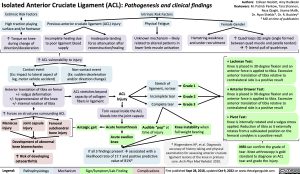Isolated Anterior Cruciate Ligament (ACL): Pathogenesis and clinical findings
Authors: Colleen Nesbitt, Amy Rudkoski Reviewers: M. Patrick Pankow, Tara Shannon, Reza Ojaghi, Usama Malik, Dr. Ryan Shields*, Dr. R. Buckley* * MD at time of publication
Female Gender
Extrinsic Risk Factors
High traction playing surface and/or footwear
↑ Torque on knee during change of direction/deceleration
Previous anterior cruciate ligament (ACL) injury
Intrinsic Risk Factors Physical Fatigue
Unknown mechanism – likely related to altered patterns in lower limb muscle activation
Incomplete healing due to poor ligament blood supply
Inadequate landing force attenuation after reconstruction/healing
Hamstring weakness and under recruitment
↑ Quadriceps (Q) angle (angle formed between quad muscle and patella tendon) à↑ lateral pull of quadriceps
+ Lachman Test:
Knee is placed in 30-degree flexion and an anterior force is applied to tibia. Excessive anterior translation of tibia relative to contralateral side is a positive result
+ Anterior Drawer Test:
Knee is placed in 90-degree flexion and an anterior force is applied to tibia. Excessive anterior translation of tibia relative to contralateral side is a positive result
+ Pivot Test:
Knee is internally rotated and a valgus stress applied. Reduction of tibia as it externally rotates from a subluxated position on the femoral condyles is a positive result
MRI can confirm the grade of tear. Knee arthroscopy is gold
standard to diagnose an ACL tear and grade the injury
↑ ACL vulnerability to injury
Contact event
(Ex: impact to lateral aspect of leg, motor vehicle accident)
Anterior translation of tibia on femur +/- valgus deformation
+/- hyperextension of the knee +/- internal rotation of tibia
↑ Forces on structures surrounding ACL
Non-contact event (Ex: sudden deceleration and/or direction change)
ACL stretches beyond capacity of collagen fibers in ligament
ACL Injury
Stretch of ligament, no tear
Incomplete tear Complete tear
Grade 1
Grade 2 Grade 3
Torn vessel inside the ACL bleeds into the joint capsule
Meniscus injury
Joint capsule Injury
Femoral subchondral bone injury
Antalgic gait
Acute hemarthrosis
Acute swollen knee
Audible “pop” at time of injury
Knee instability when full weight bearing
Development of abnormal knee biomechanics
↑ Risk of developing osteoarthritis
If all 3 findings presentàassociated with a likelihood ratio of 17.7 and positive predictive value of 81%*
* Wagemakers HP, et al. Diagnostic accuracy of history taking and physical examination for assessing anterior cruciate ligament lesions of the knee in primary care. Arch Phys Med Rehabil. 2010.
Legend:
Pathophysiology
Mechanism
Sign/Symptom/Lab Finding
Complications
First published Sept 28, 2018, updated Oct 9, 2022 on www.thecalgaryguide.com
Foundations
Systems
Other Languages
Orthopedics Knee Isolated Anterior Cruciate Ligament (ACL) Injury: Pathogenesis and clinical findings isolated-anterior-cruciate-ligament-acl-injury-pathogenesis-and-clinical-findings

